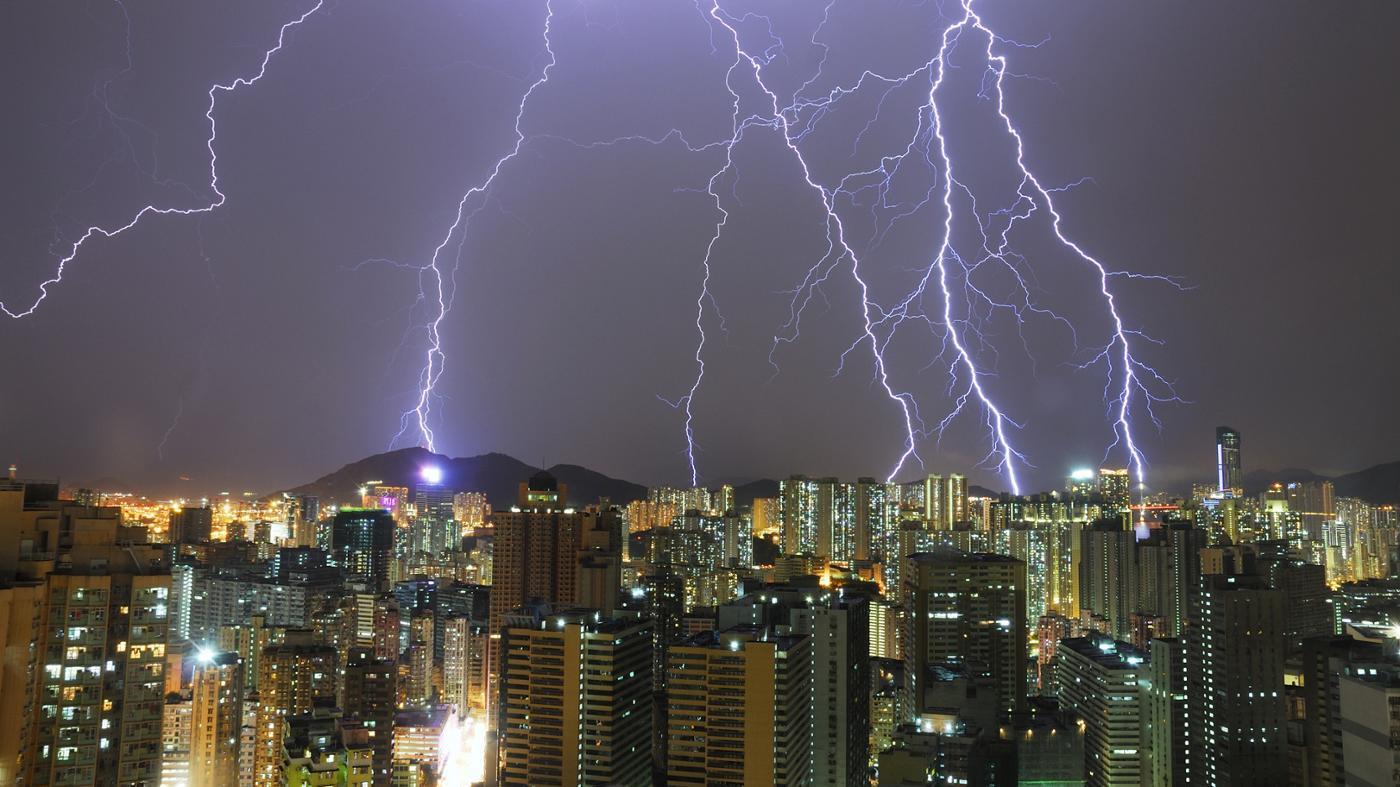Lightning protection system
Contents |
[edit] Introduction
A lightning strike can exceed 100 million Volt Amps. Any grounded object that provides a path to earth will emit upwards ‘positive streamers’ or fingers of electrical charge. These create a channel of plasma air for the huge downward currents of a lightning strike.
The high voltage currents from a lightning strike will always take the path of least resistance to ground. A lightning protection system (LPS) can protect a structure from damage caused by being struck by lightning by providing a low-resistance path to ground for the lightning to follow and disperse.
An LPS does not attract lightning, and cannot dissipate lightning, it simply provides fire and structural damage protection by preventing lightning from passing through building materials themselves.
Buildings most at risk are those at high altitudes, on hilltops or hillsides, in isolated positions and tall towers and chimneys.
[edit] Hazards of a lightning strike
In the absence of an LPS, a lightning strike may use any conductor as a path to reach ground, which could include phone cables, power cables, utilities such as water or gas pipes, or the structure itself if it is a steel frame.
Some of the main hazards presented by a lightning strike to a building include:
- Fire caused by lightning igniting flammable materials or overheating electrical wiring.
- Side flashes, when lightning jumps through the air to reach a better-grounded conductor.
- Building components can be damaged by explosive shock waves, glass shattered, concrete and plaster fragmented, and so on.
- Any electrical appliance plugged into a circuit may be badly damaged.
- The air inside porous materials such as masonry may expand rapidly.
- Materials containing moisture from humidity or rain may flash to steam.
- Other materials can reach their plastic limit and melt or ignite.
[edit] Types of LPS
[edit] Rods or ‘air terminals’
A lightning rod is a tall metallic tip, or pointed needle, placed at the top of a building. One or more conductors, often copper strips, are used to earth the rod. Rods are designed to act as the ‘terminal’ for a lightning discharge.
[edit] Conductor cables
Numerous heavy cables placed around the building in a symmetrical arrangement. This is sometimes referred to as a ‘Faraday cage’. These cables are run along the tops and around the edges of roofs, and down one or more corners of the building to the ground rod(s) which carry the current to the ground. This type of LPS may be used for buildings which are highly exposed or house sensitive installations such as computer rooms.
[edit] Ground rods
These are long, thick rods buried deep into the earth around a protected structure. They are normally made of copper or aluminium and are designed to emit positive streamers.
[edit] Designing an LPS
Inclusion of an LPS should taken into consideration during the design stage. The design should ensure that even if lightning strikes the structure first, the large voltage currents will be drawn into the LPS before serious damage can be done.
An LPS can be designed so as to utilise parts of the building that can safely carry large current loads, and draw energy away from the parts of the building that are not able to.
An LPS should be designed and installed to prevent side flashes between objects. By maintaining the electrical continuity of objects to a bonding conductor, any differences in electric potential can be zeroed, allowing any voltage changes to occur simultaneously.
Failure to design proper grounding will render an LPS ineffective as safe dispersal of the energy from the strike will not be possible. Additional earthing from that provided by a utility supplier is often required.
[edit] Related articles on Designing Buildings Wiki
Featured articles and news
The UK's Modern Industrial Strategy: A 10 year plan
Previous consultation criticism, current key elements and general support with some persisting reservations.
Building Safety Regulator reforms
New roles, new staff and a new fast track service pave the way for a single construction regulator.
Architectural Technologist CPDs and Communications
CIAT CPD… and how you can do it!
Cooling centres and cool spaces
Managing extreme heat in cities by directing the public to places for heat stress relief and water sources.
Winter gardens: A brief history and warm variations
Extending the season with glass in different forms and terms.
Restoring Great Yarmouth's Winter Gardens
Transforming one of the least sustainable constructions imaginable.
Construction Skills Mission Board launch sector drive
Newly formed government and industry collaboration set strategy for recruiting an additional 100,000 construction workers a year.
New Architects Code comes into effect in September 2025
ARB Architects Code of Conduct and Practice available with ongoing consultation regarding guidance.
Welsh Skills Body (Medr) launches ambitious plan
The new skills body brings together funding and regulation of tertiary education and research for the devolved nation.
Paul Gandy FCIOB announced as next CIOB President
Former Tilbury Douglas CEO takes helm.
UK Infrastructure: A 10 Year Strategy. In brief with reactions
With the National Infrastructure and Service Transformation Authority (NISTA).
Ebenezer Howard: inventor of the garden city. Book review.
The Grenfell Tower fire, eight years on
A time to pause and reflect as Dubai tower block fire reported just before anniversary.
Airtightness Topic Guide BSRIA TG 27/2025
Explaining the basics of airtightness, what it is, why it's important, when it's required and how it's carried out.
Construction contract awards hit lowest point of 2025
Plummeting for second consecutive month, intensifying concerns for housing and infrastructure goals.
Understanding Mental Health in the Built Environment 2025
Examining the state of mental health in construction, shedding light on levels of stress, anxiety and depression.






















